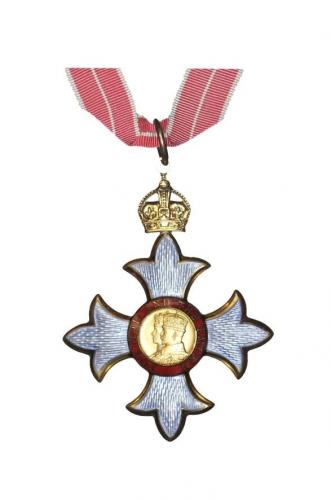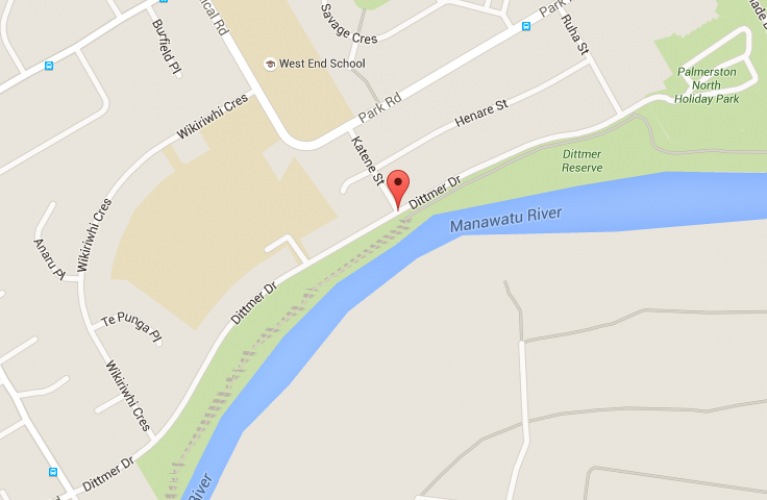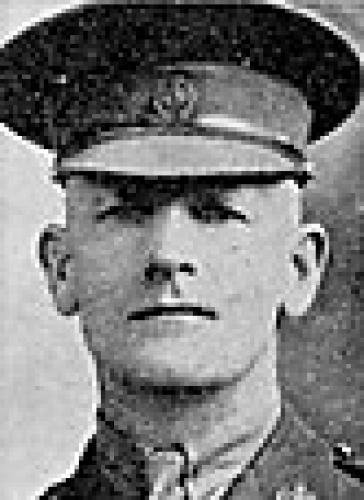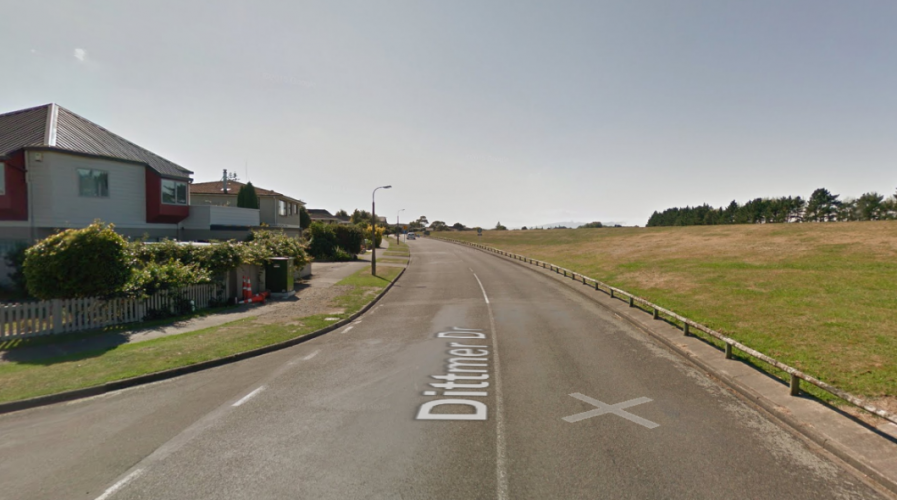095 Dittmer Drive Palmerston North, street scene 2017
Reason for the name
This street was named in honour of Brigadier George Dittmer, CBE, DSO, MBE, MZ MID Commander of the 28th Māori Battalion during the Second World War
The street view of Dittmer Drive looking north east from Wikiriwhi Crescent, with Dittmer Reserve and Manawatu River on the right. Dittmer Drive is located in a residential area and acts as the main thoroughfare for the area, following along the curve in the Manawatu River. It is an extension of Slacks Road to the west and ends near Ruha Street in the east. Dittmer Reserve runs along the southern portion of the Drive, with the Manawatu Riverside Walkway running east to west between Dittmer Drive and the Manawatu River. The Palmerston North Holiday Park and Awatapu College are also in the area.
As part of the process of subdivision and naming streets, George Dittmer was contacted in late 1964 to give his thoughts on the naming of streets after 28th Māori Battalion soldiers as a commemoration of their service to their country. Dittmer provided a comprehensive list of soldiers who had served under him which was later utilised by the Council to adopt further street names in the Awatapu subdivision. After consultation and further correspondence with the Palmerston North City Council it was decided that Awatapu Avenue would be renamed Dittmer Drive in honour of him. The resolution was passed by Council on 22 November 1965 and took effect from 1 February 1966.
Prior to its subdivision the land known as Awatapu was a golf course and grazing area situated next to the Manawatu River. In order to free up land for residential development and increase revenue, a Council meeting of 16 April 1963 resolved to subdivide the area via “disposal of sections through Land Agents at pre-determined figures fixed by the Council”. The new Awatapu College had to be allowed for, and the old Awatapu Golf Links shifted upstream to Brightwater Terrace, which then became the Palmerston North Golf Club. The main access road through the area was at first known as Awatapu Avenue.
Author: Evan Greensides, Research Assistant for Palmerston North City Library.
Brigadier George Dittmer, Commander of the 28th Māori Battalion during the Second World War, was born at Maharahara, Hawke’s Bay, on 4 June 1893. Dittmer’s career began at the age of 17 as a volunteer in D Company of the Hauraki Regiment, enlisting in the 1st Auckland Battalion at the outbreak of the First World War and sailing with the main body of the First New Zealand Expeditionary Force for Egypt with the rank of Platoon Sergeant in the Hauraki Company. Landing at Gallipoli on 25 April 1915, he served with distinction and was commissioned as a Second Lieutenant in June of that year.
After being evacuated from Gallipoli and returned to Egypt, the unit was then transferred to France in early 1916. By 1917 he had attained the rank of Captain and was awarded the Military Cross for his unwavering devotion to his unit. While serving on the Somme, Dittmer was wounded in action and evacuated to Britain for treatment. After recovering in hospital, Dittmer returned to duty in November 1917 and was appointed Major of the No 1 Entrenching Battalion, later returning to the Auckland Regiment and serving with the Army of occupation in Germany at the end of the War.
Returning to New Zealand in 1919, Dittmer was transferred to the Regular Force with the rank of Captain and held various group appointments with the Auckland District, including Officer Commanding the District School of Instruction. He was awarded the MBE in 1935.
At the outbreak of the Second World War, Dittmer held the rank of Major and was posted to the Second New Zealand Expeditionary Force. After being appointed Commander of the 28th Māori Battalion, he was promoted to Lieutenant Colonel and was sent to England for training before embarking for the Greek theatre of war. After a fighting retreat, the Battalion was evacuated to Crete where it served with distinction against the German invasion force, earning a reputation for fierce counterattacking in the process. After a further evacuation to Egypt, Dittmer was wounded and subsequently captured whilst being treated at a New Zealand medical centre near Sidi Rezegh. Taking the initiative and using the hours of darkness to his advantage, Dittmer led an escape party of 30 soldiers some 80 miles across the desert and back to British lines on the Egyptian frontier. For his actions he was awarded the Distinguished Service Order and was mentioned in despatches.
Returning to New Zealand, Lieutenant Colonel Dittmer was appointed Commander of the 1st New Zealand Mobilised Territorial Brigade Group with the temporary rank of Brigadier. This was followed by an appointment as Commander of the 1st Mobilised Division until September 1943 when he was seconded to the Fiji Military Forces and the Second New Zealand Expeditionary Force in the Pacific as Commander. Immediately after the end of the Second World War, Dittmer was made a Commander of the Most Excellent Order of the British Empire for these services in the Pacific theatre.
In 1946, Brigadier Dittmer rejoined the New Zealand Staff Corps and was appointed Camp Commandant of the newly formed Central Military District in late 1946. He retired from the Regular Force in 1948.
Honours and Awards
- Commander of the Most Excellent Order of the British Empire (CBE)
- Companion of the Distinguished Service Order (DSO). The citation reads:
For gallant leadership. This officer commanded the 28th (Māori) Battalion and in both Greece and Crete rendered conspicuous service to the Division. In Greece his Battalion held a line 5000 yards in length and was attacked along the whole of its length. Despite the fact that its line was penetrated at several points the unit made a series of determined counterattacks, restored the position, and then made its withdrawal. The success was due to the leadership of Lt Col Dittmer. In the operations in Crete the 28th Battalion established a proud record. It counter attacked the enemy on at least five occasions; inflicting heavy losses each time. It took the largest share of the rear-guard work and right to the end asserted its superiority over the enemy on the ground, and in every one of its engagements was led by its commanding officer, Lt Col Dittmer." (New Zealand Gazette, 21 September 1944)
- Military Cross (MC). The citation reads:
Period: 21 September 1916 to 28 February 1917. This officer left NZ as a Private. He has the best record for steady service in the Battalion, he has never been absent for a day save on duty or leave. No action of his stands out vividly as an example of steady bravery in action, and daily punctual devotion to duty. After September he commanded his company at the Somme." (London Gazette, 4 June 1917, p. 5486, Rec. No. 680)
- 1914-1915 Star
- British War Medal (1914-1920)
- Victory Medal
- 1939-1945 Star
- Africa Star
- Pacific Star
- Defence Medal
- War Medal 1939-1945 with oak leaf
- New Zealand War Service Medal
- New Zealand Long and Efficient Service Medal
- New Zealand Territorial Service Medal









